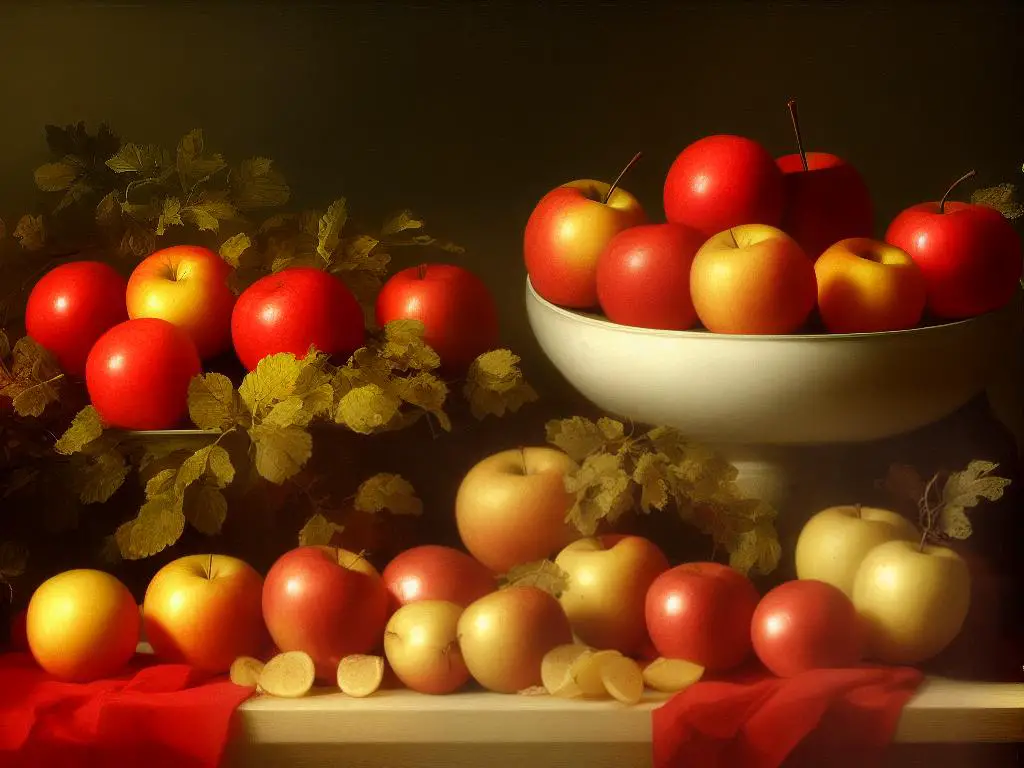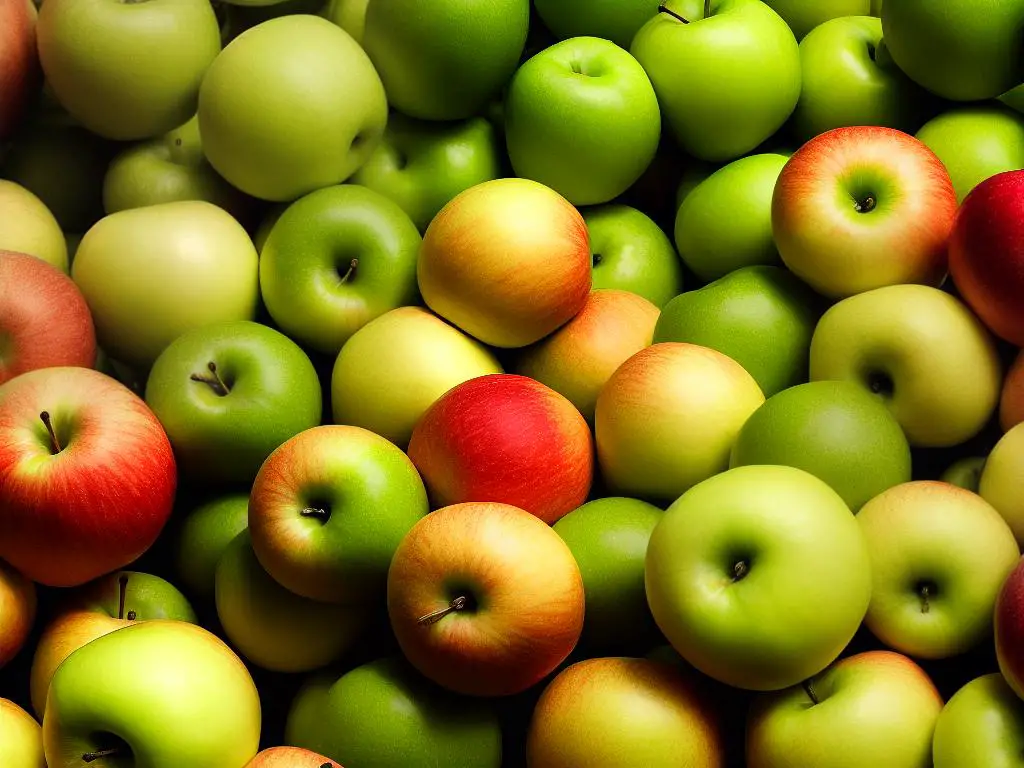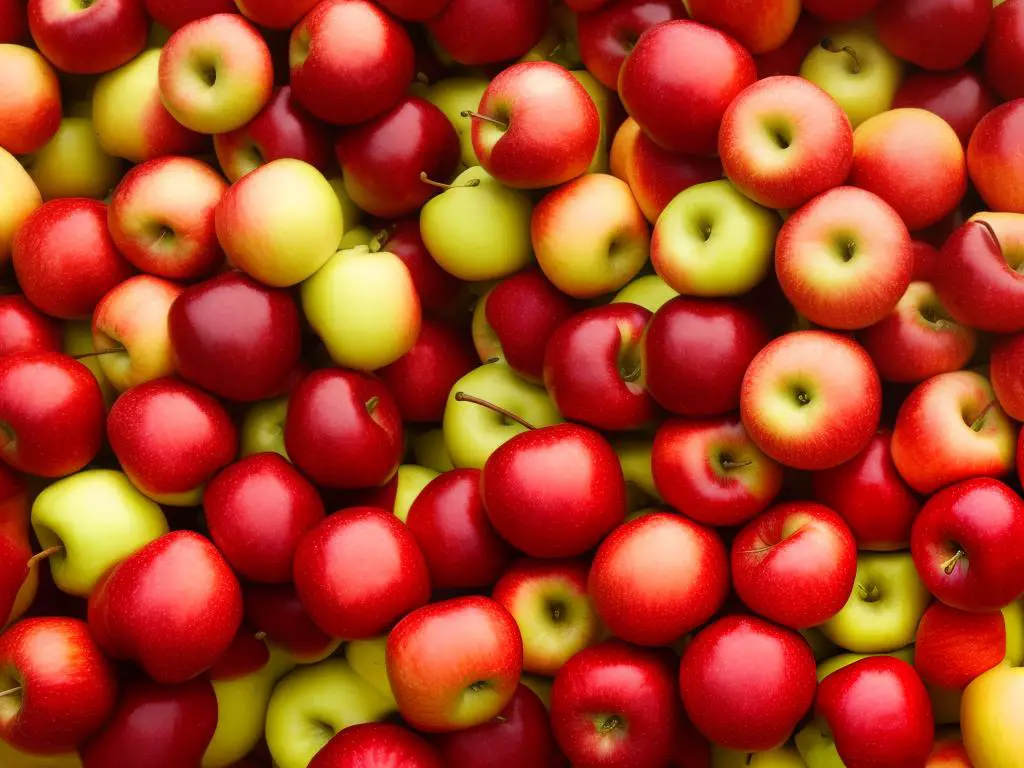Apples, one of the most beloved and widely consumed fruits around the world, hold a rich and fascinating history that spans centuries and cultures. From their origins in Central Asia to their widespread cultivation across the globe, apples have played a significant role in human civilization and continue to bring joy to countless individuals every day. This article will explore the captivating story of apples, delving into some of the most popular varieties, as well as offering practical advice for choosing and storing these delicious and nutritious fruits.
History and Origin of Apples
The history of apples
The history of apples dates back thousands of years, with their origin tracing back to Central Asia, specifically in the region around modern-day Kazakhstan. Here, wild apple trees (Malus sieversii) can still be found, which are considered the ancestors of most domesticated apple varieties we know and enjoy today. Moving through history, apples have become a staple fruit for many cultures and civilizations, as they were cherished for their taste, nutritional value, and variety.
Spread of Apples and Cultivation
As humans began to migrate and trade along the Silk Road, apples followed suit, and their cultivation extended throughout Europe, the Middle East, and eventually North America. The ancient Greeks and Romans were known to have cultivated several apple varieties, and they often wrote about apples in both their literature and historical texts. Their influence on apple propagation has been significant, as many of the apple varieties we recognize today originated in Europe.
One of the most prominent historical figures who contributed to the spread of apple cultivation was none other than Alexander the Great. He is credited with discovering the dwarf apple trees in the region of ancient Greece, which greatly facilitated the transportation and spread of apple varieties across various regions.
Apples in North America
When Europeans began to colonize North America in the 17th century, they brought apple seeds and saplings with them, making apples one of the first fruits introduced to the continent. Although crabapple is the only indigenous apple variety that grows in North America, the early settlers’ efforts eventually led to the cultivation of many different apple types throughout the region.
John Chapman, better known as Johnny Appleseed, further enhanced the distribution and popularity of apples in the United States during the 19th century. As an American nurseryman, he traveled throughout the northeastern and midwestern territories of the United States planting apple seeds, resulting in the establishment of numerous apple orchards that would eventually make the country one of the largest apple producers globally.
Importance of Apples in History
Throughout history, apples have had profound cultural, religious, and mythological significance in many societies. They have been regarded as symbols of love, knowledge, and immortality. In Greek mythology, apples were seen as a symbol of beauty and played a crucial role in the story of the Golden Apple of Discord. In biblical references, apples are often associated with knowledge and the story of Adam and Eve.
An Introduction to Apple Varieties
Apples are a staple fruit enjoyed worldwide for their delicious taste, versatility in culinary applications, and numerous health benefits. With over 7,500 varieties of apples grown globally, and around 2,500 varieties cultivated in the United States, it is no surprise that the range of flavors, textures, and appearances found in this fruit is vast. Some of the most well-known and popular apple varieties include Red Delicious, Golden Delicious, Granny Smith, Fuji, Gala, and McIntosh.
The history of apples dates back thousands of years, and the widespread cultivation of this fruit spans across continents. This makes apples an important part of human history, with their influence poised to continue well into the future. Given the incredible diversity of apple types, it can be hard to keep track of them all, but we will begin by exploring some standout varieties that are especially beloved for their taste, texture, appearance, and culinary uses.

Popular Apple Varieties
Exploring Popular Apple Varieties
In this informative deep-dive into popular apple varieties, we will examine the unique characteristics of each type, such as their color, taste, texture and ideal uses in cooking or baking. Additionally, we will discuss their growing seasons, regions, and nutritional content, as each apple variety can bring something special to the table.
It is important to note that while there are thousands of apple varieties across the globe, some are more widely recognized and preferred than others. We will be focusing on these standout types in order to provide an overview of the apples most commonly enjoyed by people around the world.
Granny Smith
Granny Smith apples are known for their vibrant green color and tart, tangy taste. They have a firm texture that holds up well when cooked, which makes them a popular choice for apple pies, tarts, and other baked goods. Granny Smith apples are also excellent for eating fresh or in salads due to their crisp bite. This variety originated in Australia and is available year-round. Nutritionally, Granny Smith apples are packed with vitamin C and fiber, making them a healthy snacking option.
Gala
Gala apples are a popular variety known for their sweet taste, red-orange color, and thin skin. They have a relatively soft texture, making them best for eating fresh or using in applesauce. Galas are not a top choice for baking but can still be used if other varieties are unavailable. These apples originate from New Zealand but are now grown widely in the United States. They are available year-round but are most plentiful during the late summer and fall months. Like other apple varieties, Gala apples are high in vitamin C and fiber.
Honeycrisp
As the name suggests, Honeycrisp apples are known for their honey-like sweetness and crisp texture. This variety is a favorite for eating fresh and is often found sliced and ready to eat in grocery stores due to its sturdy texture. Honeycrisps have a vibrant red and yellow color and are primarily grown in the United States. They are available from September through February. Honeycrisp apples are also high in vitamin C and fiber, making them yet another nutritious snacking option.
Fuji
Fuji apples are a Japanese variety with a sweet, lightly tart flavor. They have a crisp, dense texture and a red and yellow-striped skin. Due to their firm texture and flavor, Fuji apples are suitable for eating fresh, cooking, or baking. They maintain their texture well when cooked, making them ideal for pies and other baked dishes. Fuji apples are available from October through May. They are also high in vitamin C and fiber, like other popular apple varieties.
Golden Delicious
Golden Delicious apples are aptly named for their golden-yellow color and sweet, mild taste. This apple has a tender texture, making it great for eating fresh or incorporating into smooth applesauce. Although not the best for baking whole, Golden Delicious apples can be used when making pies or tarts if combined with a firmer variety, such as Granny Smith. They are available year-round but are most plentiful during the fall. As far as nutrition is concerned, Golden Delicious apples contain vitamin C and fiber.
Introduction to Apples
Apples are one of the most popular fruits in the world, with numerous varieties available to suit different tastes and uses. When it comes to choosing and storing apples for the best quality and freshness, there are a few factors you should keep in mind. In this article, we will discuss the characteristics of some popular apple varieties, as well as provide tips for selecting and storing them. By understanding these factors, you can make informed decisions when selecting apples for specific recipes or snacking purposes.

Choosing and Storing Apples
Popular Apple Varieties and Their Uses
Apples not only offer a range of flavors and textures but also have numerous health benefits due to their high vitamin C and fiber content. There is an apple variety perfectly suited for every taste and culinary need. For example, you might enjoy biting into a crisp Honeycrisp, blending a Golden Delicious applesauce, or savoring a Granny Smith apple pie. As you explore different apple varieties, you will discover even more delightful flavors and uses for this versatile fruit.
Choosing Apples
The first step in choosing apples is to think about what you’ll be using them for. Different apple varieties have different characteristics, making them suitable for various purposes. For instance, some apples are better for snacking on, while others are best for cooking or baking. While Granny Smith apples are tart and crisp and work well for pies, Honeycrisp apples are sweet and crunchy, making them perfect for eating fresh.
Factors to Consider When Choosing Apples
Firmness
- Choose apples that feel firm, avoiding any with soft spots, as these can indicate over-ripe or damaged fruit.
- Press your thumb gently on the apple’s skin – it should give slightly but bounce back to its original shape.
Color
- Look for apples that have a bright, shiny color.
- The color of the apple can vary depending on the variety, but in general, apples should have a uniform color across their surface.
- Avoid apples with wrinkled, brown, or discolored skin, as this can indicate poor quality or age.
Aroma
- A high-quality apple should have a fragrant aroma.
- Take a moment to sniff the apple – if it smells sweet and fresh, it’s a good indicator of quality and ripeness.
- Any unpleasant odors or a lack of scent may signal an old or compromised apple.
Storing Apples
Once you’ve selected your apples, proper storage techniques can help maximize their freshness and quality. Here are some strategies to keep in mind:
Temperature
- Apples are best stored in a cool, dark place.
- The ideal temperature for storing apples is around 30-32 degrees Fahrenheit (0-2 degrees Celsius).
- Storing apples in the refrigerator’s crisper drawer can help maintain this temperature and prolong their freshness.
Humidity
- Apples need some humidity to stay fresh and crisp.
- If refrigerating, placing a damp paper towel in the crisper drawer will ensure the apples have the right level of moisture.
Separation
- Apples release ethylene gas, which can cause other fruits and vegetables to ripen more quickly.
- If storing apples in the refrigerator, keep them separate from other produce to prevent premature ripening and spoilage.
Shelf-life
- Different apple varieties have different shelf-lives, with some lasting longer in storage than others.
- For instance, Red Delicious apples can last for 3-4 weeks in the refrigerator, while Granny Smith apples can stay fresh for up to 2 months.
- Check the specific variety’s expected shelf life to make sure you’re consuming them at their peak freshness.
Closing
In conclusion, when choosing apples, look for firmness, color, and aroma as indicators of quality. Store your apples in a cool, dark, and humid environment, preferably separate from other produce, to maintain their freshness and flavor. By considering these factors and following these tips, you can enjoy delicious, high-quality apples that stay fresh for an extended period.

Throughout history, apples have had a strong presence in our diets, culture, and environment. With countless varieties to choose from, each boasting unique flavors, textures, and uses, it is no wonder that apples remain a favorite among fruit lovers globally. By learning more about the apple’s rich history and the characteristics of different varieties, we can better appreciate this incredible fruit and make informed choices when selecting and storing apples to enjoy. Next time you take a bite of a crunchy, juicy apple, take a moment to appreciate all the tales, traditions, and efforts that have led to its journey from seed to table.
